Digital Revolution in Spatial Planning: The Potential of Geolocation Data in Czechia
Abstract
1. Introduction
- (a)
- Utilises characteristic daily and weekly population rhythms derived from MNO data to identify functional types of municipalities at a regional scale (Vysočina Region), encompassing a broad spectrum of settlement types.
- (b)
- Introduces a method for the systematic classification of municipalities into these types.
- (c)
- Through case studies of representative municipalities, the paper demonstrates how the derived typologies can be directly translated into specific, data-driven recommendations for spatial planning practice.
2. Literature Review
2.1. Time Geography, Temporal Rhythms, Mobility, and Spatial Change
2.2. Geolocation Data
2.3. Novelty and Contribution
3. Materials and Methods
3.1. Study Area: Vysočina Region
3.2. Definition of Present Population Categories
3.3. Methodological Framework for Data Collection
3.4. Methodology for Municipality Typology
| Set of municipalities , for the Vysočina Region) | |
| Set of typologies , see definitions below in the text) | |
| Set of days of the week () | |
| Set of hours within a day () | |
| Basic criterion for municipality and typology | |
| Primary criterion for municipality | |
| Present population on day and hour | |
| Number of permanent residents in municipality | |
| Percentage share by which municipality falls into typology | |
| Representation of typology in municipalities | |
| Representation of typology by the number of permanent residents |
| Municipalities with a high proportion of commuters | |
| Municipalities with a high proportion of out-commuters | |
| Municipalities with sudden visitor influxes | |
| 4 | Recreational municipalities with a fluctuating present population. |
4. Results
4.1. Typology of Municipalities in the Vysočina Region
4.2. Case Studies of Municipality Types
4.2.1. Type 1—Municipalities with a High Proportion of Commuters
- Integration of public transport with other modes of transport, aiming to reduce dependence on individual car transport among daily commuters.
- Development of cycling and pedestrian infrastructure connecting the industrial zone with surrounding residential areas, serving as an alternative for a portion of daily commuters.
- Optimization of workplace arrangements to minimize traffic congestion during morning and afternoon peak hours, when the data indicate the greatest population movement.
- Provision of public amenities for employees (e.g., kindergartens, sports facilities) directly within the zone or in its vicinity to reduce the number of additional trips during the day or after work.
- Other solutions—such as establishing a green belt, landscape protection, and mitigating the impacts of production—are relevant consequences of the zone’s existence, the scale of which, in terms of mobility, the data helped to quantify.
4.2.2. Type 2—Municipalities with a High Proportion of Out-Commuters
- Creation of high-quality public spaces (parks, squares) to support community life and residents’ leisure activities during the times they are present (evenings, weekends).
- Provision of public amenities (kindergartens, sports facilities, basic services) to enhance the quality of life for residents and potentially reduce the need for some trips outside the municipality.
- Development and provision of accessible public technical infrastructure and services, scaled to meet the needs of the resident population (present mainly outside working hours).
- Identification of suitable areas for the development of cycling infrastructure to support local mobility and potentially alternative commuting options.
- Supporting the development of sustainable and accessible public transport for easier and more environmentally friendly daily out-commuting, a pattern clearly indicated by the data.
4.2.3. Type 3—Municipalities with Sudden Visitor Influxes
- Optimization of parking provision while simultaneously promoting sustainable forms of transport to manage the surge arrival of visitors identified by the data, especially on weekends.
- Supporting the development of sustainable and accessible public transport as an alternative to individual car transport, which is observed to be dominant during these visitor peaks.
- Development and provision of accessible public technical infrastructure and services (water supply, sewage system, wastewater treatment plant with sufficient capacity to handle the short-term but intensive loads caused by the influx of visitors.
- Development of a waste management strategy capable of handling increased waste generation during visitor peaks.
4.2.4. Type 4—Recreational Municipalities with a Fluctuating Present Population
- In municipalities with a high proportion of recreational properties, there are significant seasonal and weekend fluctuations in water consumption and wastewater production, as indicated by the dynamics of the present population revealed by the data. This places increased demands on the capacity and operational efficiency of these facilities.
- Limits on the total number of beds in recreational properties should be introduced to prevent infrastructure overload during the weekend and seasonal peaks, as indicated by the data.
- Introduction of strict regulations for the new construction of recreational properties (regarding height, density, and materials) in the context of protecting the landscape character of the Protected Landscape Area and managing the load resulting from the weekend population.
- Support for affordable housing for permanent/local residents as a counterbalance to the pressure of second homes on property prices and to maintain a permanent community.
- Investment in infrastructure for active mobility (cycling, pedestrian) and support for public transport to reduce car dependency among weekend visitors and residents.
4.2.5. Type 5—Municipalities with a Stable Present Population
- Integrate future population projections and demographic analyses (including age structure and migration patterns) into spatial planning and strategy development, aiming to maintain current stability and prevent future imbalances.
- Develop and provide accessible public technical infrastructure, utilities, and services scaled to the needs of the stable resident population, supporting local self-sufficiency and reducing the need for out-commuting (as indicated by data).
- Identify and propose proactive measures to reduce the negative effects of transportation, addressing local traffic loads (e.g., from industry, transit traffic) even within a stable population context.
- Support the local economy and diversification of job opportunities for the long-term maintenance of the population stability identified by the research, which is linked to the expansion of buildable areas designated for production within the spatial plan.
- Protect key landscape elements (woodlands, riparian zones, and high-quality agricultural soils) from development pressures.
4.3. Comparison of Daytime and Nighttime Population
- Temporal structure within the week: Comparison of day and night time and monitoring changes in activities in a given area.
5. Discussion
5.1. Comparison with the Existing Literature
5.2. Key Contributions and Insights
5.3. Potential for Optimization in Spatial Planning
- Optimization of public infrastructure location: Finding the best place for public infrastructure facilities (e.g., waste management or healthcare facilities) for efficient servicing of regions with minimal costs and maximum accessibility, using data on needs, networks, and costs.
- Optimization of public transport: Design of routes and schedules based on detailed spatiotemporal demand data from mobile data, especially for commuting centers and residential municipalities, e.g., [56].
5.4. Limitations and Future Research
6. Conclusions
Author Contributions
Funding
Data Availability Statement
Conflicts of Interest
References
- Novák, J.; Novobilský, J. Inovativní přístupy k zachycení přítomného obyvatelstva: Data mobilních operátorů. Urban. A Územní Rozv. 2013, 16, 14–19. [Google Scholar]
- Ouředníček, M.; Špačková, P. Populační Vývoj v Zázemí Českých Měst Jako Důsledek Procesu Suburbanizace: Analytické Texty k Souboru Specializovaných Map. Praha; Přírodovědecká fakulta UK v Praze: Prague, Czech Republic, 2013. [Google Scholar]
- Pospíšilová, L.; Novák, J. Mobile phone location data: New challenges for demographic research. Demogr. Rev. Pro Výzkum Popul. Vývoje 2016, 58, 320–337. [Google Scholar]
- Halás, M.; Blažek, V.; Klapka, P.; Kraft, S. Population movements based on mobile phone location data: The Czech Republic. J. Maps 2021, 17, 116–122. [Google Scholar] [CrossRef]
- Ahas, R.; Aasa, A.; Yuan, Y.; Raubal, M.; Smoreda, Z.; Liu, Y.; Ziemlicki, C.; Tiru, M.; Zook, M. Everyday space–time geographies: Using mobile phone-based sensor data to monitor urban activity in Harbin, Paris, and Tallinn. Int. J. Geogr. Inf. Sci. 2015, 29, 2017–2039. [Google Scholar] [CrossRef]
- Ahas, R.; Aasa, A.; Silm, S.; Tiru, M. Daily rhythms of suburban commuters’ movements in the Tallinn metropolitan area: Case study with mobile positioning data. Transp. Res. 2010, 18, 45–54. [Google Scholar] [CrossRef]
- Anejionu, O.C.D.; Sun, Y.; Thakuriah, P.; McHugh, A.; Mason, P. Spatial Urban Data System: A Cloud-Enabled Big Data Infrastructure for Social and Economic Urban Analytics. Future Gener. Comput. Syst. 2019, 98, 456–473. [Google Scholar] [CrossRef]
- Liu, K.; Murayama, Y.; Ichinose, T. A multi-view of the daily urban rhythms of human mobility in the Tokyo metropolitan area. J. Transp. Geogr. 2021, 9, 102985. [Google Scholar] [CrossRef]
- Yuan, L.; Sho, K.; Eom, S.; Nishi, H.; Hasegawa, D.; Zhao, H.; Aoki, T.; Zhu, J.; Matsuo, K.; Masumura, A. Changes in visitor behaviour across COVID-19 pandemic: Unveiling urban visitation dynamics and non-linear relationships with the built environment using mobile big data. Habitat Int. 2024, 154, 103216. [Google Scholar] [CrossRef]
- Bibri, S.E.; Krogstie, J. Data-Driven Smart Sustainable Cities of the Future: A Novel Model of Urbanism and Its Core Dimensions, Strategies, and Solutions. J. Futur. Stud. 2020, 25, 77–94. [Google Scholar] [CrossRef]
- Wu, Y.; Shen, T.; Li, Y.; Kita, M.; Yoshida, Y.; Sho, K.; Yuan, L.; Yu, L.; Jiang, R.; Long, Y. Exploring urban railway station-based attractiveness considering demographic-specific demands: Case study of Odakyu line, Japan. Cities 2025, 158, 105620. [Google Scholar] [CrossRef]
- Muliček, O.; Osman, R.; Seidenglanz, D. Urban rhythms: A chronotopic approach to urban timespace. Time Soc. 2015, 24, 304–325. [Google Scholar] [CrossRef]
- Osman, R.; Ira, V.; Trojan, J. A tale of two cities: The comparative chrono-urbanism of Brno and Bratislava public transport systems. Morav. Geogr. Rep. 2020, 28, 269–282. [Google Scholar] [CrossRef]
- Osman, R.; Mulíček, O. Urban chronopolis: Ensemble of rhythmized dislocated places. Geoforum 2017, 85, 46–57. [Google Scholar] [CrossRef]
- Šveda, M.; Sládeková Madajová, M.; Barlík, P.; Križan, F.; Šuška, P. Mobile phone data in studying urban rhythms: Towards an analytical framework. Morav. Geogr. Rep. 2020, 28, 248–258. [Google Scholar] [CrossRef]
- Edensor, T. Geographies of rhythm: Nature, place, mobilities and bodies. Ashgate 2012, 129–134. [Google Scholar]
- Nemeškal, J.; Ouředníček, M.; Pospíšilová, L.; Frydrych, P. Real Population and Daily Mobility in Prague and the Central Bohemian Region. In Prague and Central Bohemia: Current Population Processes and Socio-Spatial Differentiation; Ouředníček, M., Ed.; Karolinum Press: Praha, Czech Republic, 2022; pp. 91–108. [Google Scholar]
- Nemeškal, J.; Ouředníček, M.; Pospíšilová, L. Temporality of urban space: Daily rhythms of a typical week day in the Prague metropolitan area. J. Maps 2020, 16, 30–39. [Google Scholar] [CrossRef]
- Hägerstrand, T. What about people in regional science? Reg. Sci. Assoc. 1970, 24, 7–21. [Google Scholar] [CrossRef]
- Hagget, P. Geography: A Modern Synthesis; Harper & Row Publishers: New York, NY, USA, 1975. [Google Scholar]
- Frantál, B.; Klapka, P.; Siwek, T. Lidské chování v prostoru a čase: Teoreticko-metodologická východiska. Czech Sociol. Rev. 2012, 48, 833–857. [Google Scholar] [CrossRef]
- Ellegård, K. Time Geography—From the Past to the Future. In Thinking Time Geography; Ellegård, K., Ed.; Routledge: London, UK, 2019; pp. 151–156. [Google Scholar] [CrossRef]
- Crang, M. Rhythms of the City: Temporalised Space and Motion. In Timespace: Geographies of Temporality; May, J., Thrift, N., Eds.; Routledge: London, UK, 2003. [Google Scholar]
- Lefebvre, H. Rhythmanalysis: Space, Time and Everyday Life; Editions Syllepse: Paris, France, 2004. [Google Scholar]
- Óvari, K.; Kočiš, M. Priestorová diferenciácia rozmiestnenia obyvateľstva v kontexte súčasného pobytu v Slovenskej republike k 1. 1. 2021. Slov. Stat. A Demogr. 2023, 2, 5–29. [Google Scholar]
- Bengston, L.; Lu, X.; Thorson, A.; Garfield, R.; Von Schreeb, J. Improved response to disasters and outbreaks by tracking population movements with mobile phone network data: A post-earthquake geospatial study in Haiti. PLoS Med. 2011, 8, e1001083. [Google Scholar] [CrossRef]
- Šveda, M.; Sládeková Madajová, M.; Hurbánek, P.; Rosina, K. Spracovanie Pasívnych Lokalizačných Údajov Mobilnej Siete na Použitie v Experimentálnej Populačnej Štatistike; Institute of Geography Slovak Academy of Sciences: Bratislava, Slovakia, 2024. [Google Scholar]
- Pospíšilová, L. Denní Rytmus Lokalit Pražského Centra. In Sociální Proměny Pražských Čtvrtí; Ouředníček, M., Temelová, J., Eds.; Academia: Praha, Czech Republic, 2012; pp. 136–158. [Google Scholar]
- Mareggi, M. Urban Rhythms in the Contemporary City. In Space–Time Design of the Public City; Springer: Berlin/Heidelberg, Germany, 2013; pp. 3–20. [Google Scholar]
- Drevon, G.; Gwiazdinski, L.; Klein, O. Chronotopies-Lecture et Écriture des Mondes en Mouvement; Elya Éditions: Grenoble, France, 2017. [Google Scholar]
- Burcin, B.; Čermák, Z.; Drbohlav, D.; Hampl, M.; Kučera, T. Faktické Obyvatelstvo Hlavního Města Prahy. In Výzkumná Zpráva; Univerzita Karlova v Praze, Přírodovědecká fakulta: Praha, Czech Republic, 2008. [Google Scholar]
- Tussupova, A.; Beikitova, A.; Mustafin, M.; Satybaldiyev, O.; Lewis, D.J. Analysis of Spatial Aggregation and Activity of the Urban Population of Almaty Based on Cluster Analysis. Sustainability 2024, 17, 3243. [Google Scholar] [CrossRef]
- Isaacman, S.; Becker, R.; Caceres, R.; Kobourov, S.; Martonosi, M.; Rowland, J.; Varshevsky, A. Ranges of human mobility in Los Angeles and New York. In Proceedings of the IEEE International Conference on Pervasive Computing and Communications Workshops, Seattle, WA, USA, 21–25 March 2011; pp. 88–93. [Google Scholar]
- Novák, J.; Ahas, R.; Aasa, A.; Silm, S. Application of mobile phone location data in mapping of commuting patterns and functional regionalization: A pilot study of Estonia. J. Maps 2013, 9, 10–15. [Google Scholar] [CrossRef]
- Esch, T.; Asamer, H.; Bachofer, F.; Zeidler, J.N. Digital World Meets Urban Planet-New Prospects for Evidence-Based Urban Studies Arising from Joint Exploitation of Big Earth Data, Information Technology and Shared Knowledge. Int. J. Digit. Earth 2020, 2, 136–157. [Google Scholar] [CrossRef]
- Zwirowicz-Rutkowska, A.; Michalik, A. Spatial Data Infrastructure and Mobile Big Data for Urban Planning Based on the Example of Mikolajki Town in Poland. Appl. Sci. 2024, 14, 9117. [Google Scholar] [CrossRef]
- Novák, J. Lokalizační Data Mobilních Telefonů: Možnosti Využití v Geografickém Výzkumu. Disertační Práce; Univerzita Karlova v Praze, Přírodovědecká Fakulta, Katedra Sociální Geografie A Regionálního Rozvoje: Praha, Czech Republic, 2010. [Google Scholar]
- Novák, J.; Temelová, J. Každodenní život a prostorová mobilita mladých Pražanů: Pilotní studie využití lokalizačních dat mobilních telefonů. Czech Sociol. Rev. 2012, 48, 911–938. [Google Scholar] [CrossRef]
- Halás, M.; Klapka, P. The Timescape of the City: Example of Spatial Interactions Based on Big Data; Habitat International: Atlanta, GA, USA, 2023. [Google Scholar] [CrossRef]
- Kraft, S.; Květoň, T.; Blažek, V.; Pojsl, L.; Rypl, J. Travel diaries, GPS loggers and smartphone applications in mapping the daily mobility patterns of students in an urban environment. Morav. Geogr. Rep. 2020, 28, 259–268. [Google Scholar] [CrossRef]
- Šveda, M.; Križan, F. Využitie Lokalizačných Údajov Mobilnej Siete v Priestorových Analýzach; Univerzita Komenského v Bratislavě: Bratislava, Slovakia, 2022. [Google Scholar]
- Šveda, M.; Hurbánek, P.; Sládeková Madajová, M.; Rosina, K.; Förstl, F.; Záboj, P.; Výbošťok, J. When spatial interpolation matters: Seeking an appropriate data transformation from the mobile network for population estimates. Comput. Environ. Urban Syst. 2024, 110, 102106. [Google Scholar] [CrossRef]
- Klapka, P.; Ellegård, K.; Frantál, B. What about time-geography in the post-COVID-19 era? Morav. Geogr. Rep. 2020, 28, 238–247. [Google Scholar] [CrossRef]
- Ministerstvo vnitra ČR. Metodický Postup Řešení: Zlepšení Podmínek pro Decentralizaci a Dostupnost Veřejné Správy v Území. Finální Databáze 4; Ministerstvo vnitra ČR: Prague, Czech Republic, 2023.
- Jaroš, V. Geolocation Data as a Research Tool for the Organization of the Settlement System and Mobility Mapping—Case Study of the Spatial Mobility Model in Czechia. In AI, Data, and Digitalization, Proceedings of the First International Symposium SAIDD 2023, Sogndal, Norway, 9–10 May 2023; Springer: Berlin/Heidelberg, Germany, 2023. [Google Scholar] [CrossRef]
- Frydrych, P.; Ouředníček, M.; Nemeškal, J. Reálná Noční Populace v Katastrálních Územích Prahy a v Obcích Středočeského Kraje. Specializovaná Mapa; Univerzita Karlova, Přírodovědecká fakulta, Katedra sociální geografie a regionálního rozvoje, Urbánní a regionální laboratoř: Praha, Czech Republic, 2020. [Google Scholar]
- Raun, J.; Järv, O.; Okkonen, P.; Rantanen, M.; Hyyryläinen, T.; Ryynänen, T.; Toivonen, T. New avenues for second home tourism research using big data: Prospects and challenges. Curr. Issues Tour. 2022, 26, 1–13. [Google Scholar] [CrossRef]
- Gallent, N.; Hamiduddin, I. COVID-19, second homes and the challenge for rural amenity areas. Town Plan. Rev. 2020. ahead-of-print. [Google Scholar] [CrossRef]
- Fialová, D. Transformace Druhého Bydlení (v Zázemí Prahy). Dizertační Práce; Katedra sociální geografie a regionálního rozvoje Přírodovědecké fakulty Univerzity Karlovy v Praze: Praha, Czech Republic, 2000. [Google Scholar]
- Fialová, D. Tradiční a Nové Formy Druhého Bydlení Jako Významná Součást Vnitrostátního Cestovního Ruchu. 5. Mezinárodní kolokvium o Cestovním Ruchu; Masarykova univerzita nakladatelství: Brno, Czech Republic, 2014. [Google Scholar]
- Vágner, J.; Fialová, D. Regionální Diferenciace Druhého Bydlení v Česku Regional Differentiation of Second Homes in the Czech Republic; Univerzita Karlova v Praze, Přírodovědecká fakulta, Katedra sociální geografie a regionálního rozvoje: Praha, Czech Republic, 2004; p. 286. [Google Scholar]
- Bičík, I.; Fialová, D.; Vágner, J. Druhé Bydlení v Česku. Second Homes in the Czech Republic; Katedra sociální geografie a regionálního rozvoje Přírodovědecké fakulty Univerzity Karlovy v Praze: Praha, Czech Republic, 2001. [Google Scholar]
- Mulíček, O.; Osman, R.; Seidenglanz, D. Time–space rhythms of the city—The industrial and postindustrial Brno. Environ. Plan. 2016, 48, 115–131. [Google Scholar] [CrossRef]
- Luo, H.; Huang, B. A probabilistic framework with the gradient-based method for multi-objective land use optimization. Int. J. Geogr. Inf. Sci. 2023, 37, 1128–1156. [Google Scholar] [CrossRef]
- Guo, Y.; Jiao, L.; Sun, Y.; Zhang, H.; Liu, Z.; Xu, G. A novel urban population-land coupling simulation model: Integrating spatial equilibrium and macro-micro strategies. Int. J. Appl. Earth Obs. Geoinf. 2024, 132, 104002. [Google Scholar] [CrossRef]
- Ezquerro, S.; Alonso, B. Optimisation and Land Use-Transport Interaction Models. In Land Use–Transport Interaction Models; CRC Press: Boca Raton, FL, USA, 2017; pp. 87–102. [Google Scholar]
- Zhang, H.; Zeng, Y.; Tan, R.; Liu, H. A model for regional land use optimization allocation based on multi-agent system and its application. Acta Geogr. Sin. 2011, 66, 972–984. [Google Scholar] [CrossRef]
- Ren, Z.; Lu, X. Using GA for land use planning. In Proceedings of the 4th International Workshop on Advanced Computational Intelligence, New York, NY, USA, 19–21 October 2011; pp. 64–69. [Google Scholar]
- Wang, S.-D.; Wang, X.-C.; Zhang, H.-B. Simulation on optimized allocation of land resource based on DE-CA model. Ecol. Model. 2015, 314, 135–144. [Google Scholar] [CrossRef]
- Cao, K.; Zhou, C.; Church, R.; Li, X.; Li, W. Revisiting spatial optimization in the era of geospatial big data and GeoAI. Int. J. Appl. Earth Obs. Geoinf. 2024, 129, 103832. [Google Scholar] [CrossRef]


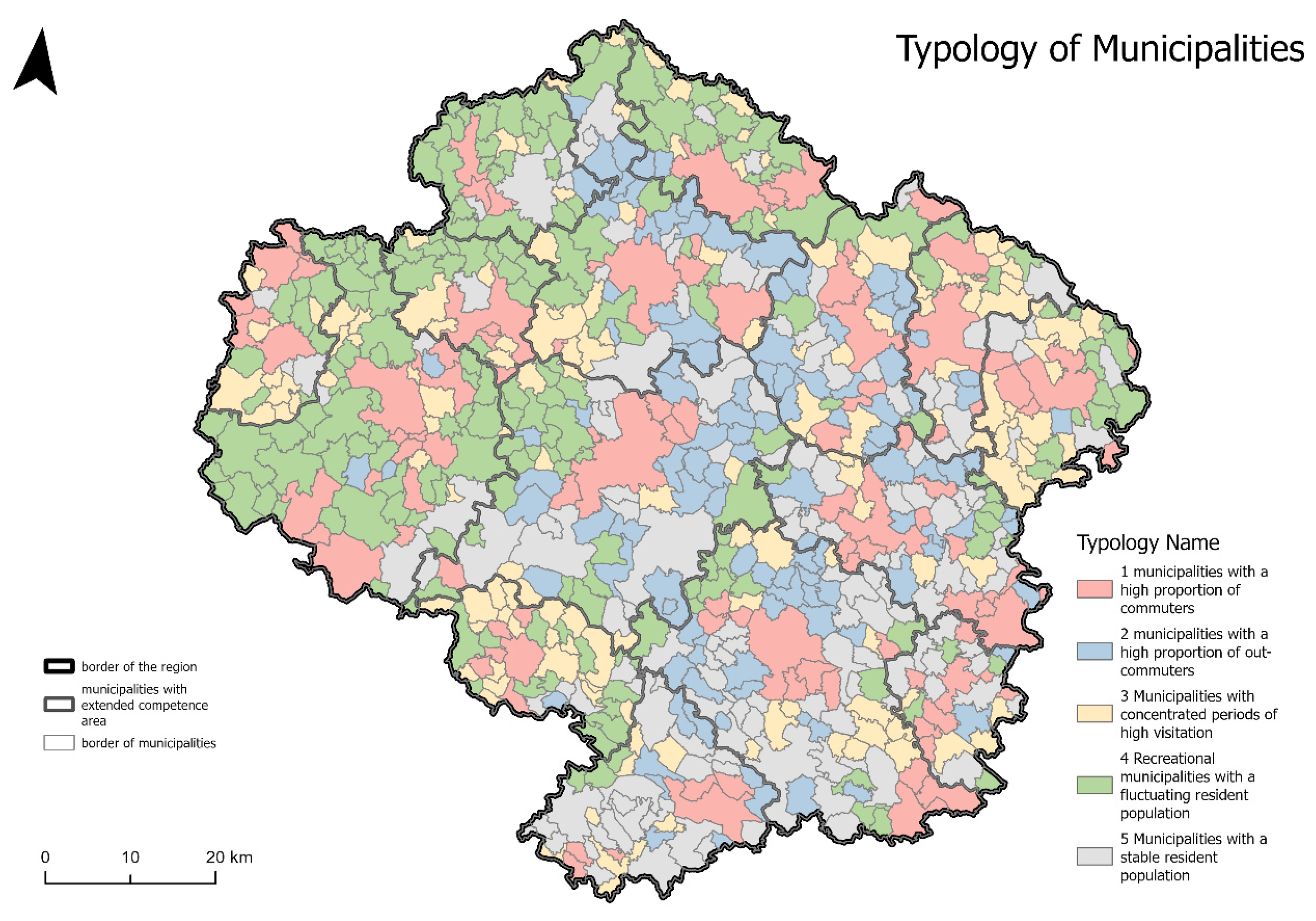
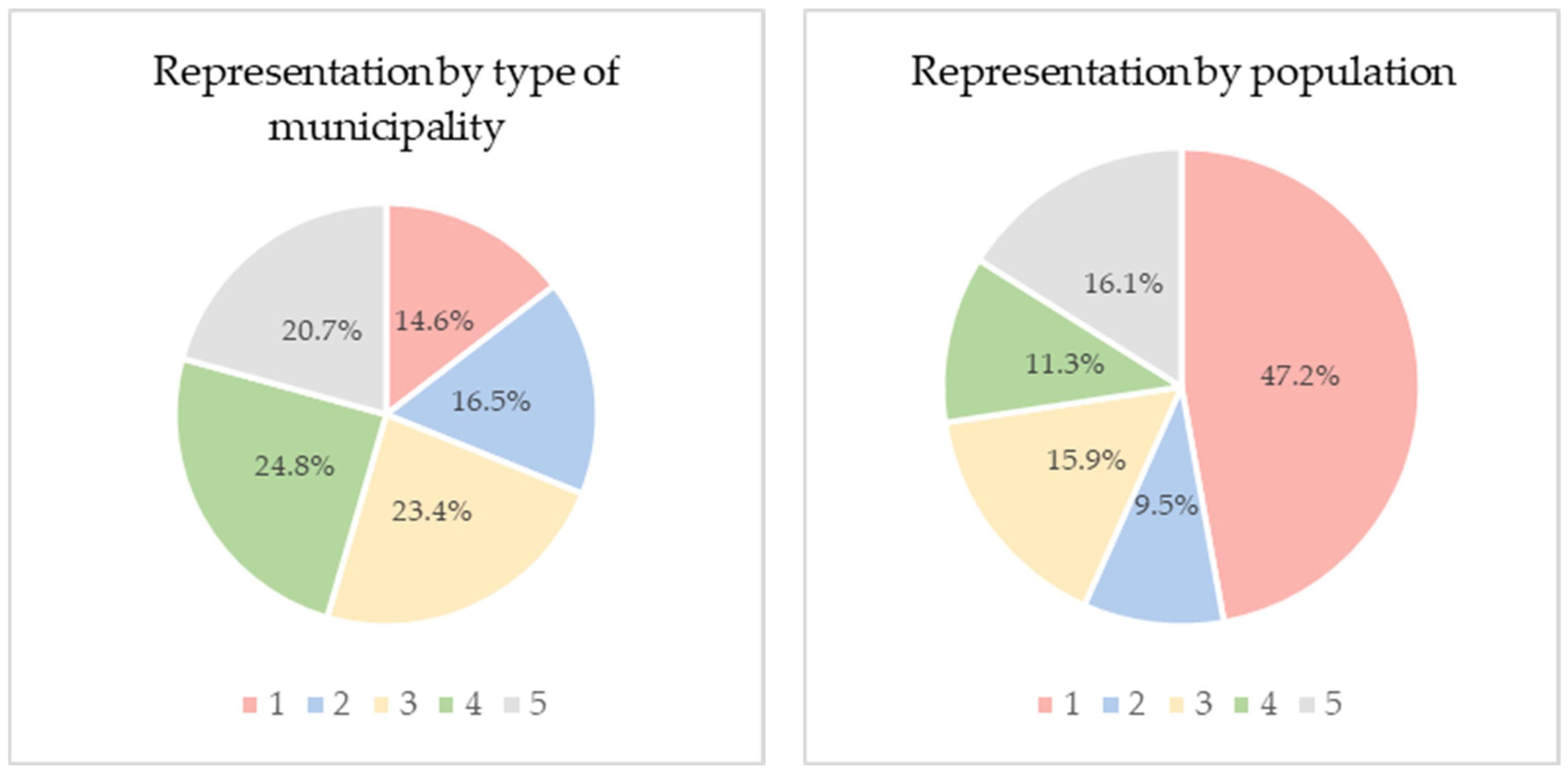
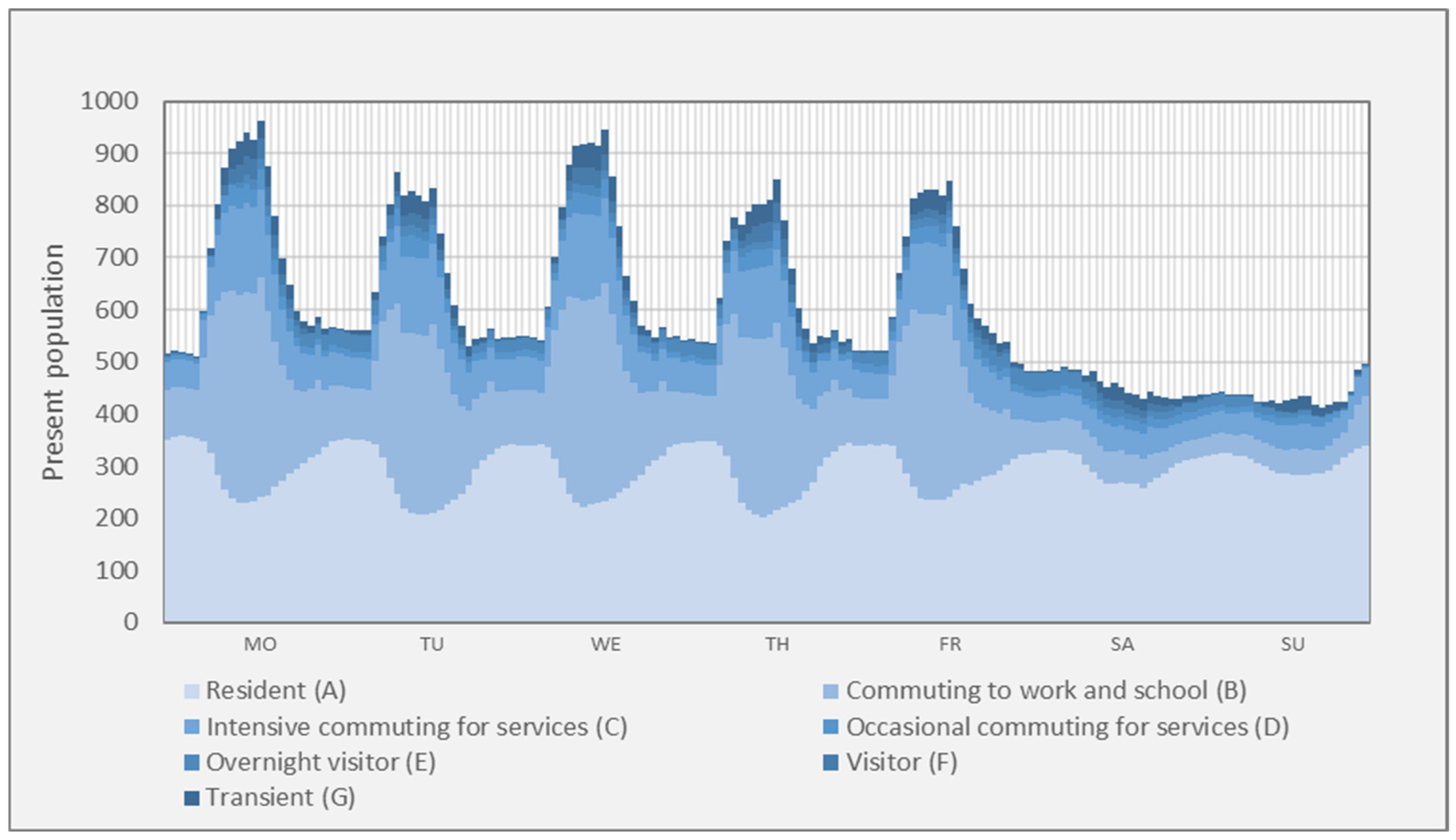
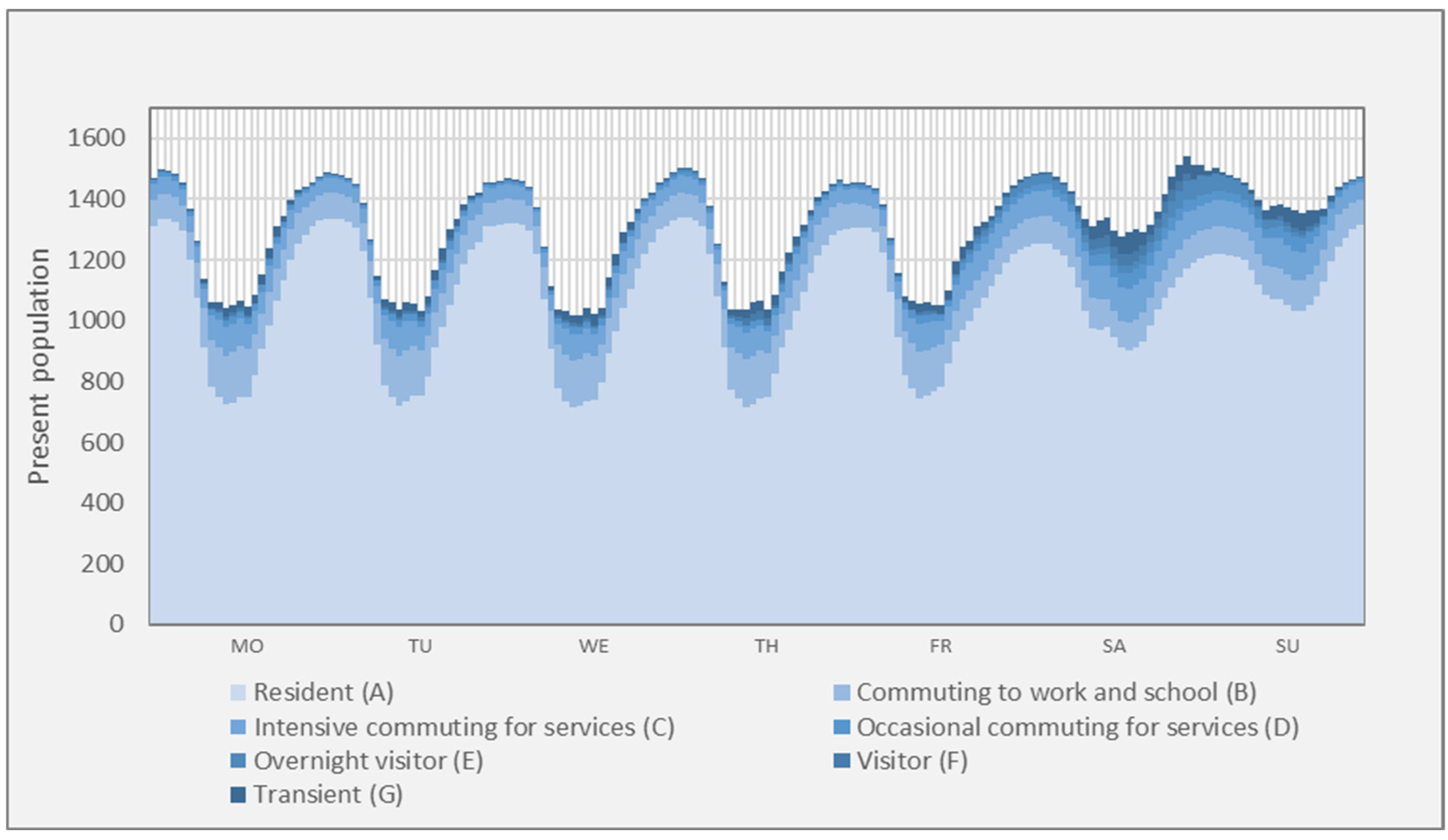
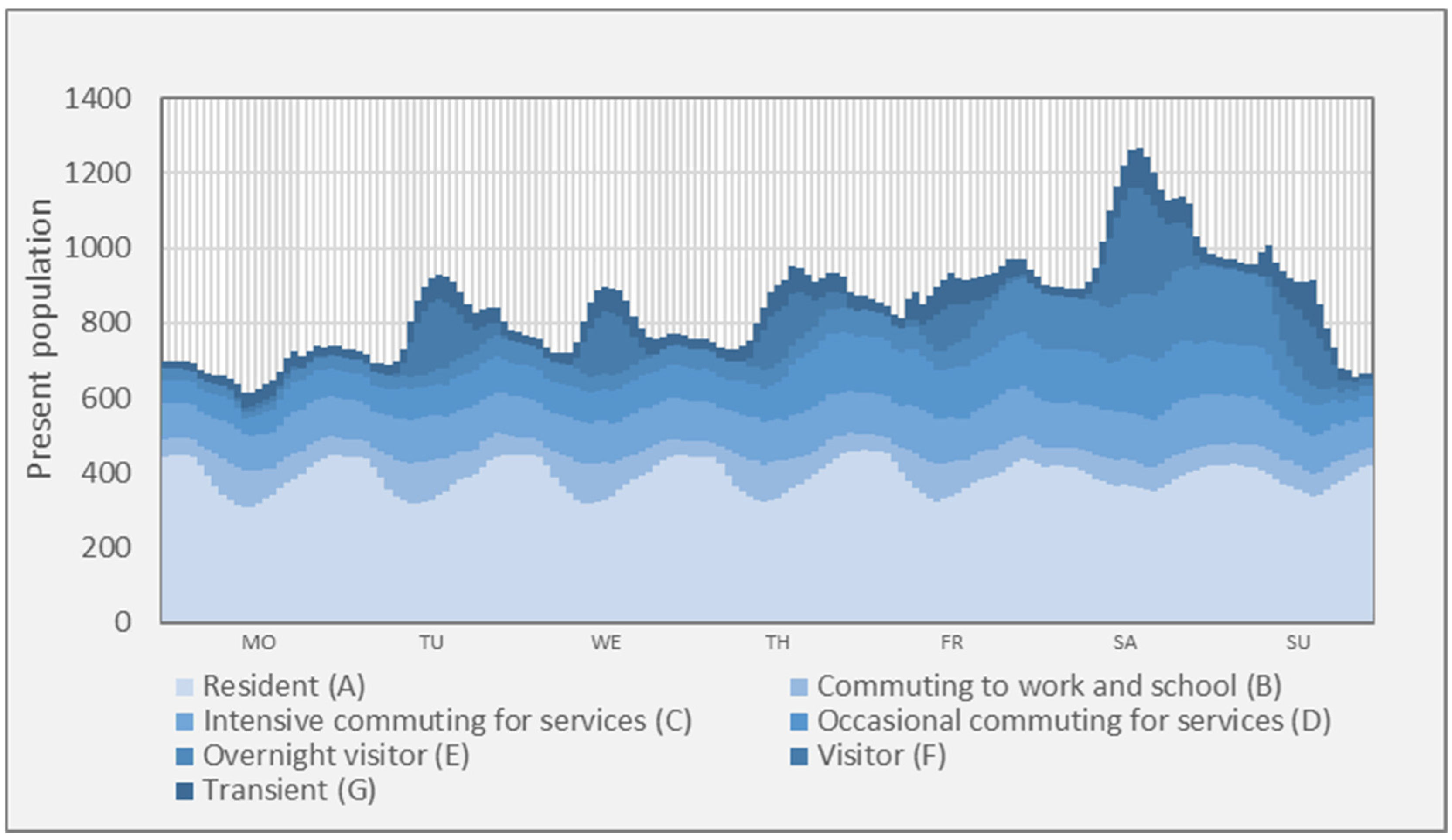

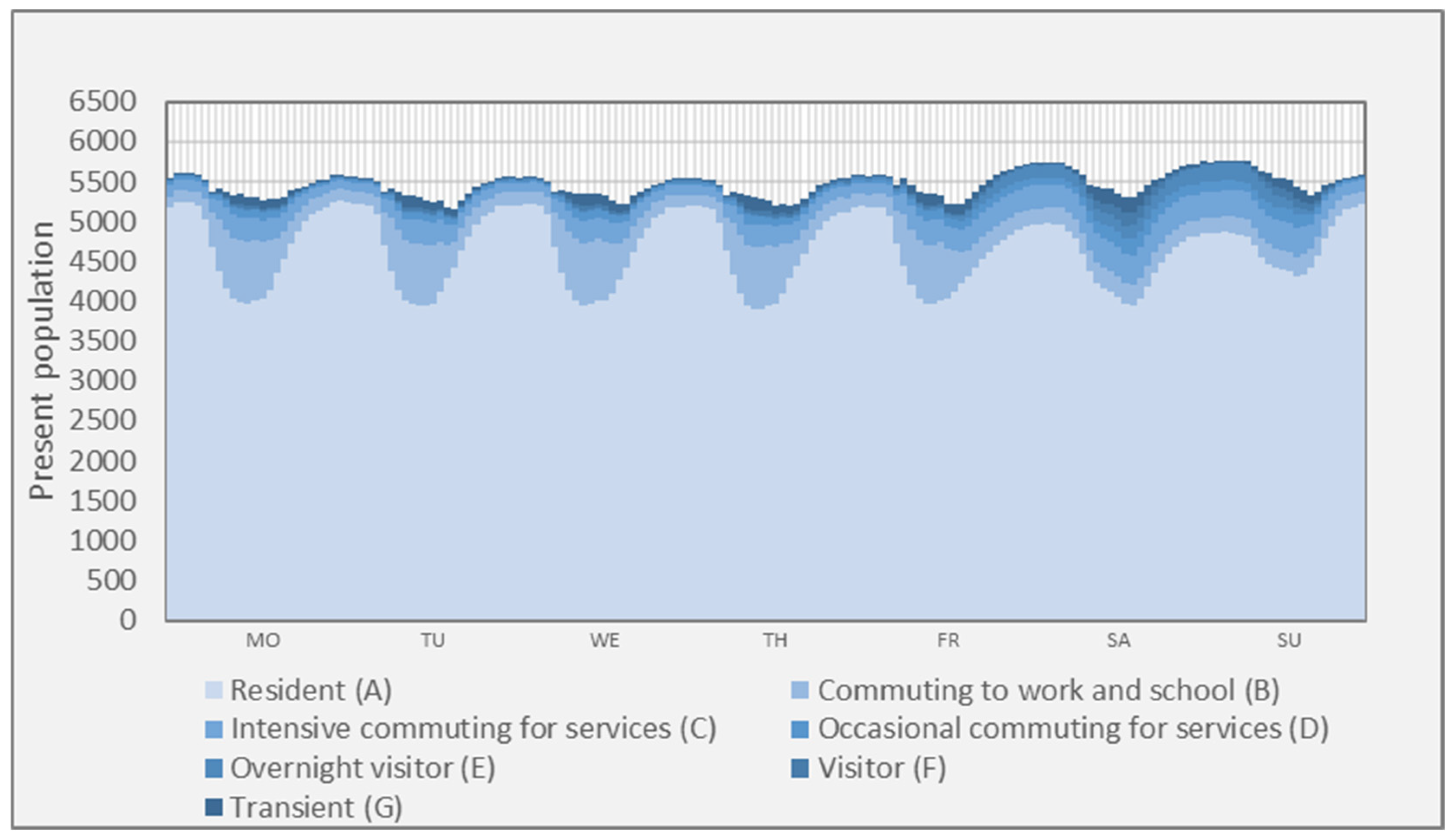
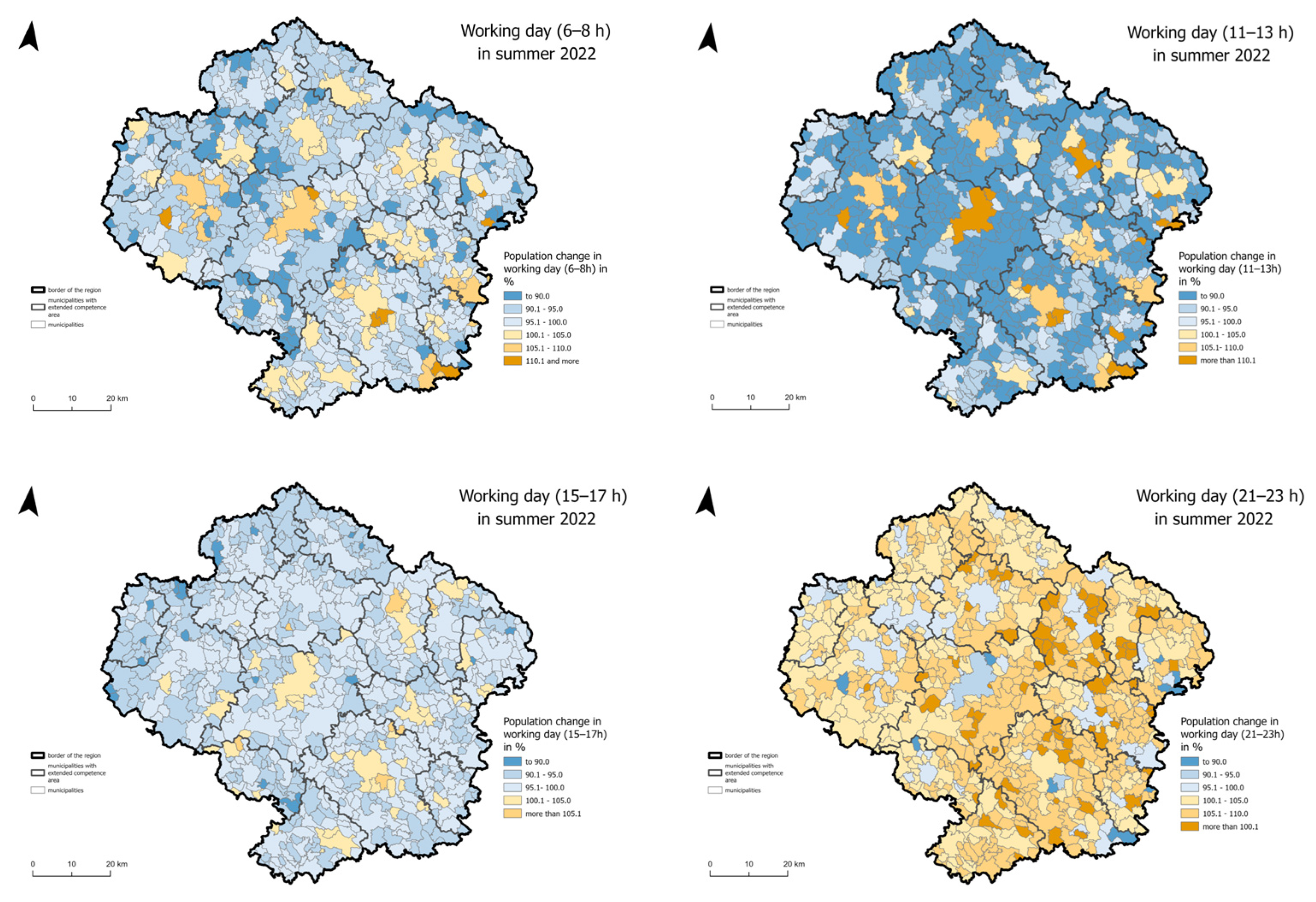
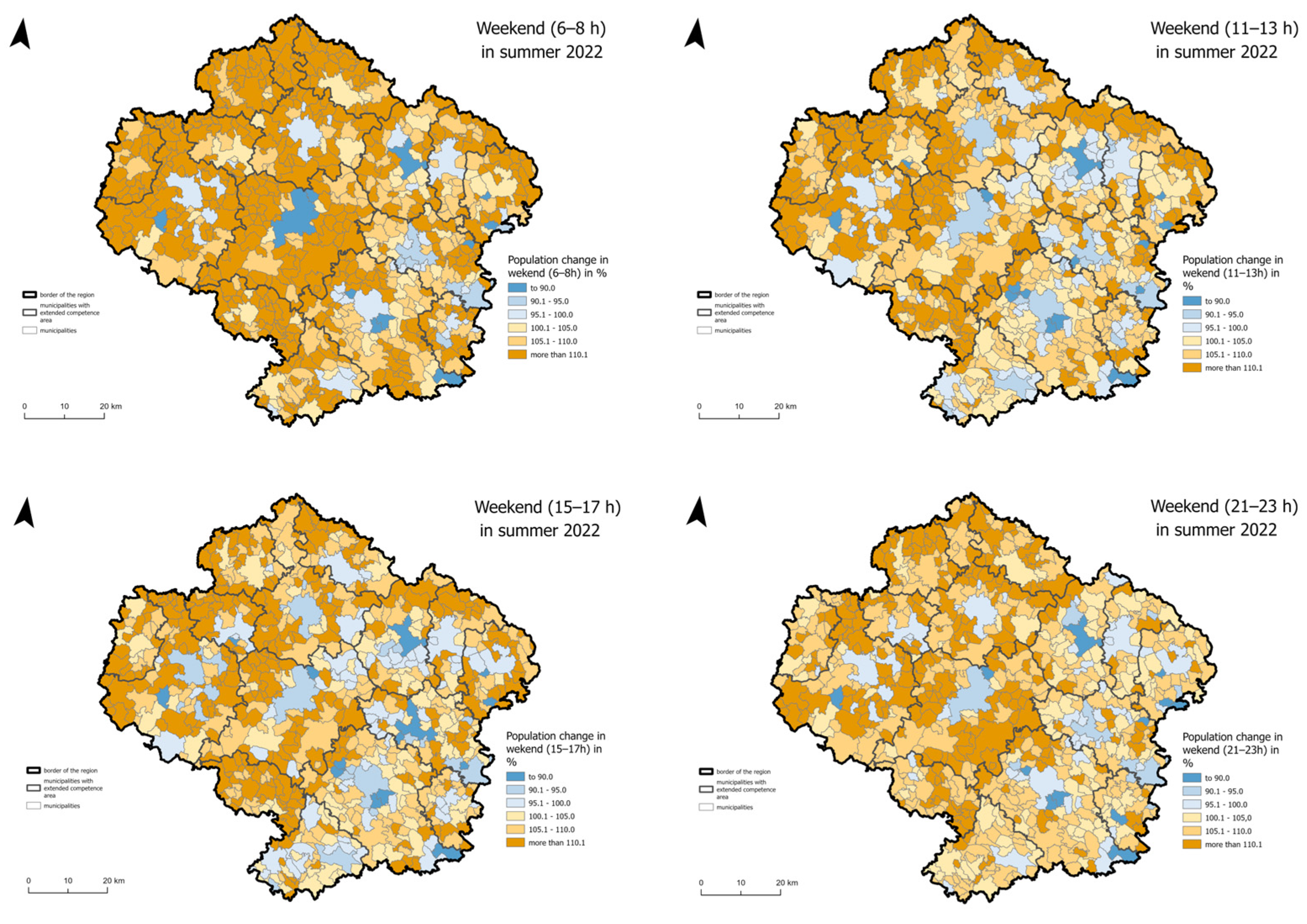
| Typology | Name of Typology | Comment |
|---|---|---|
| Resident | Resident (A) | Individuals for whom the locality constitutes the dominant place of overnight stay for an extended period (e.g., one month or more). |
| Regularly non-resident | Commuting to work and school (B) | The most intensive type of commuting. |
| Intensive commuting for services (C) | A type of commuting comparable to regular commuting for services, particularly shopping, as well as cultural, social, and sporting services, or visits to relatives and friends, etc. | |
| Occasional commuting for services (D) | This pattern is comparable to non-daily travel for particular services, such as cultural, social, sporting, and other facilities, medical appointments, administrative errands, or visits to family and friends. | |
| Non-recurring non-resident | Overnight visitor (E) | An individual who is neither a resident of the municipality nor commutes to it regularly nor owns a second home there but nonetheless stays overnight. |
| Visitor (F) | An individual visiting the municipality on a single occasion and staying for at least 3 h who does not fall into any of the three previously mentioned categories of recurring commuters. | |
| Transient and other (G) | Number of persons whose primary residence was in the municipality during the given interval and who have no other connection to the municipality. |
| Typology | Name of Typology | Comment |
|---|---|---|
| j = 1 | Municipalities with a high proportion of commuters | These municipalities are characterized by a high influx of commuters during the day for work, study, and services. The difference between nighttime and daytime populations is analyzed to define this category. |
| j = 2 | Municipalities with a high proportion of out-commuters | These municipalities function primarily as residential areas and experience a substantial daytime population outflow. The difference between nighttime and daytime population levels is analyzed to define this category, with a focus on daytime reduction. |
| j = 3 | Municipalities with sudden visitor influxes | These municipalities are characterized by short-term, high-intensity visitor influxes, typically on weekends, holidays, or during the season, due to tourism and events. These influxes are identified by analyzing population time profiles for rapid, short-term increases. |
| j = 4 | Recreational municipalities with a fluctuating present population | These municipalities are typical of recreational areas and are characterized by a variable number of people depending on the season, weather, and other factors affecting recreation. |
| j = 5 | Municipalities with a stable present population | These municipalities exhibit a relatively stable number of people over time without significant daily, weekly, or seasonal fluctuations. To define this category, the variability in the number of people in the municipality is monitored across different time horizons. |
Disclaimer/Publisher’s Note: The statements, opinions and data contained in all publications are solely those of the individual author(s) and contributor(s) and not of MDPI and/or the editor(s). MDPI and/or the editor(s) disclaim responsibility for any injury to people or property resulting from any ideas, methods, instructions or products referred to in the content. |
© 2025 by the authors. Licensee MDPI, Basel, Switzerland. This article is an open access article distributed under the terms and conditions of the Creative Commons Attribution (CC BY) license (https://creativecommons.org/licenses/by/4.0/).
Share and Cite
Jirásek, P.; Šomplák, R. Digital Revolution in Spatial Planning: The Potential of Geolocation Data in Czechia. Urban Sci. 2025, 9, 158. https://doi.org/10.3390/urbansci9050158
Jirásek P, Šomplák R. Digital Revolution in Spatial Planning: The Potential of Geolocation Data in Czechia. Urban Science. 2025; 9(5):158. https://doi.org/10.3390/urbansci9050158
Chicago/Turabian StyleJirásek, Petr, and Radovan Šomplák. 2025. "Digital Revolution in Spatial Planning: The Potential of Geolocation Data in Czechia" Urban Science 9, no. 5: 158. https://doi.org/10.3390/urbansci9050158
APA StyleJirásek, P., & Šomplák, R. (2025). Digital Revolution in Spatial Planning: The Potential of Geolocation Data in Czechia. Urban Science, 9(5), 158. https://doi.org/10.3390/urbansci9050158








